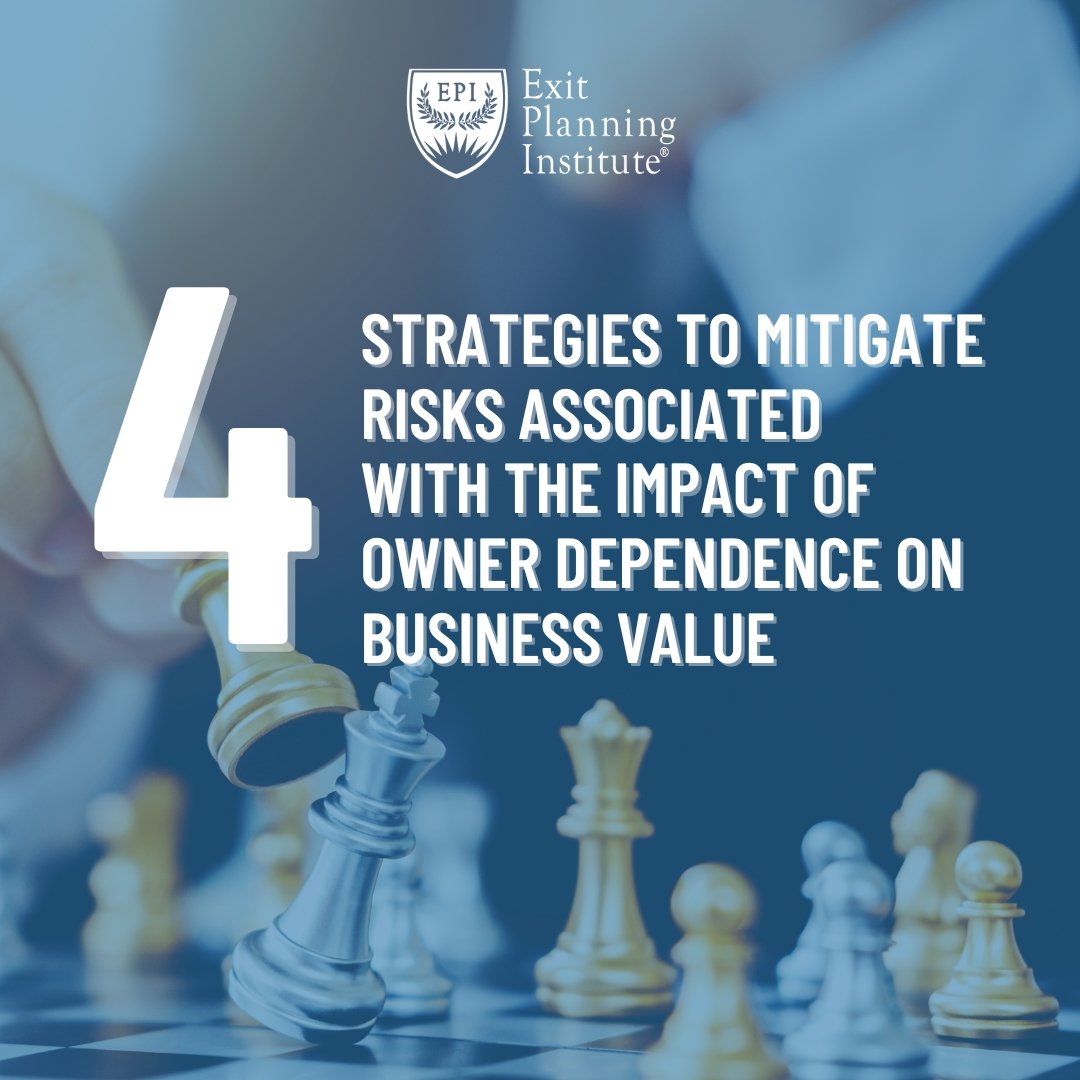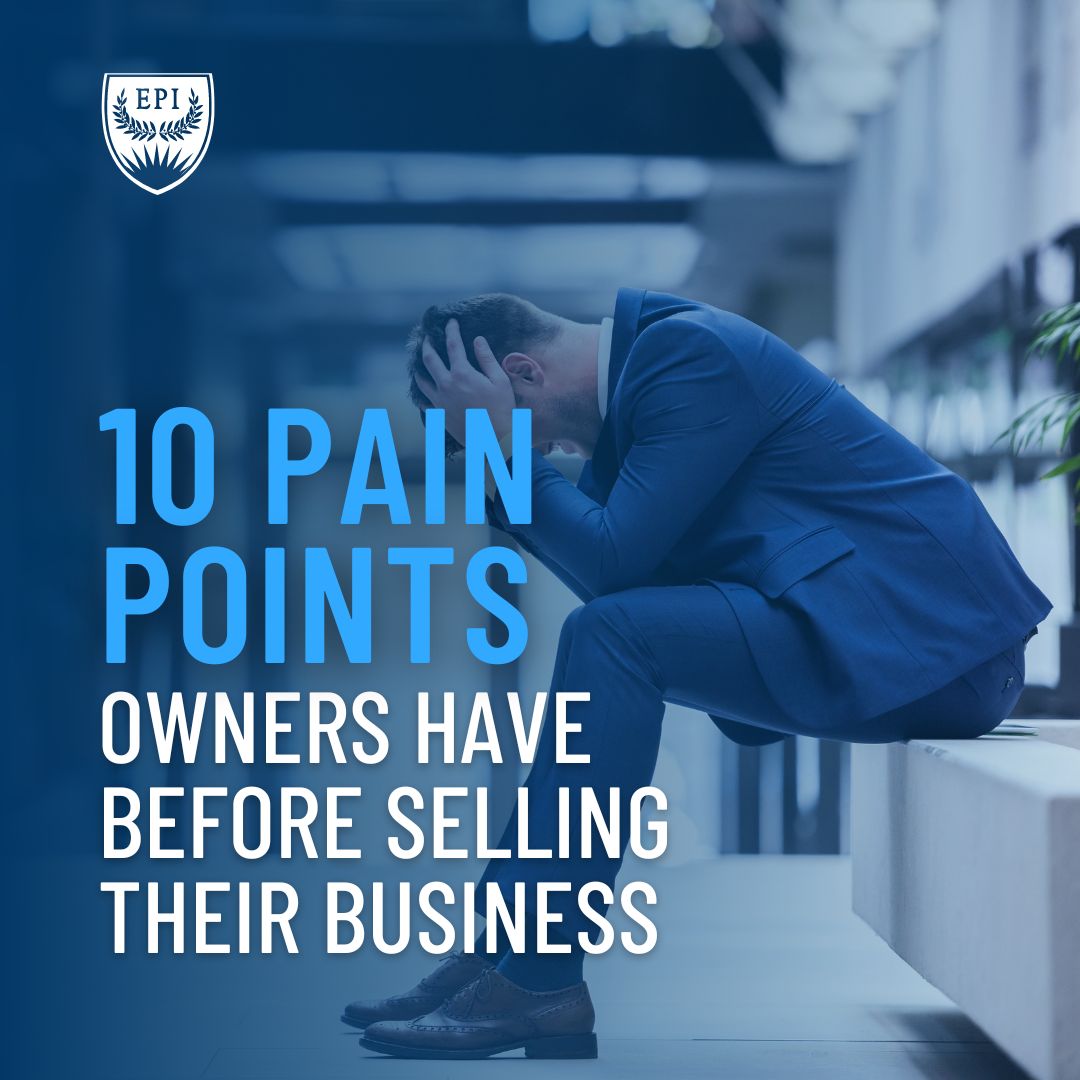
THE EXIT PLANNING BLOG
Keep up-to-date with exit planning, succession planning, industry trends, unique specialty insights, and useful content for professional advisors and business owners.
Share this
Top 4 Strategies to Mitigate Risks Associated with the Impact of Owner Dependence on Business Value
by Colleen Kowalski on January 16, 2024

A business dependent on the owner will never reach its full value potential because most of the value in the business is locked in the owner. Should the owner leave the business, they are likely taking customers and processes with them. Additionally, the brand and the owner have become synonymous, so if the owner exits, the value of the business decreases.
We spoke with four Certified Exit Planning Advisors® (CEPAs) to see what strategies they recommend for owners looking to decentralize themselves from their businesses. See what Sharon Olson, Christian Muntean, Steve Jackson, and Lynsey Peterson suggest to their clients below!
An Emphasis on Communication
Sharon Olson, Founder and President of Olson Wealth Group and CEPA® since 2021, believes that the key to mitigating the risks owners face during a transition is effective and deliberate communication. She shares, “Be clear about what you are trying to accomplish and why. Share the message internally and externally so you are ahead of the change curve. Also, develop client retention and employee retention contingency plans in case clients and employees perceive decentralization as the first step toward a sale that will result in loss of service for clients or jobs for employees.”
Practice Your Exit
For owners who are deeply entrenched in every facet of their business, Christian Muntean, President of Vantage Consulting and CEPA® since 2019, suggests they complete what he calls a “practice exit.” He continues, “My favorite strategy is to send owners on a long vacation. These are ‘practice exits.’ They don’t have to go on a vacation, but they do have to go away. A successful practice exit is one where the business continues to operate, problem solve, and even grow in an owner’s absence.”
For this “practice exit” to be successful the owner and their advisory team must ensure the company is set to run without the owner. This includes building a management team, delegating key tasks, setting up financial controls, and documenting operations and systems. Christian says, “I find that practice exits are challenging for many owners. But they are also fun to do. This is important because many owners are uncomfortable with the emotions that an exit can bring up, so it’s important to find ways to reframe it as a positive.”
Evaluating Key Owner Goals
Steve Jackson, Financial Advisor with Edward Jones and CEPA® since 2022, shares, “An effective plan sets personal goals for the owner, identifies personal financial results from a transaction, highlights ways to increase the value of the business, identifies a potential successor, addresses legal and tax considerations, and provides contingency plans for unforeseen circumstances.”
Chris Snider writes in Walking To Destiny, “Before goals comes purpose.” When an owner understands their 'personal purpose, they set themselves down a path toward a more fulfilling life after they exit their business in the future while also creating a more meaningful life in the present. By managing their energy and optimizing their current life, owners can explore their passions outside of their business. Passions that can ultimately make up a large portion of their next act.
Establishing Key Leadership Roles
Lynsey Peterson, a Fractional Integrator for companies running on EOS® through Catalyst Integrators and CEPA® since 2023, shares, “Deciding to form a strong leadership team to run the business and adopt an operating system is the first step I recommend business owners take to begin decentralizing themselves from their business. As we build trust and competence in the leadership team and thoughtfully integrate the operating system, we improve alignment, ensure accountability, and create a sustainable rhythm. This continually moves us toward the goal of a self-managing company.”
Establishing a strong leadership team to fulfill some of the daily responsibilities of the owner provides more robust human capital and builds value in the business. Lynsey continues, “We start by building out an accountability chart to get a sense of what roles are required for running the business in the next 6-12 months. Once we know the seats, then we add the people who are right to fill each one. That allows us to identify all of the different roles the owner is filling and which ones are most ready for someone else to take over. We look for the right person to take over key roles, usually aiming for one big ‘people move’ per quarter.”
One of the easiest ways to build business value – and limit the amount of time you as an owner spend working outside of traditional work hours – is to decentralize yourself from the business.
Learn how to decentralize yourself from your business here!
Share this
- Blog (545)
- CEPA (423)
- exit planning (249)
- CEPA community (187)
- Business Owner (172)
- Exit Planning Summit (97)
- EPI Chapter Network (89)
- Value Acceleration Methodology (80)
- Exit Planning Partner Network (76)
- EPI Announcement (49)
- Content (48)
- Webinars (37)
- Excellence in Exit Planning Awards (33)
- Marketing (30)
- 2024 Exit Planning Summit (28)
- 5 Stages of Value Maturity (26)
- Books (24)
- EPI Academy (24)
- EPI Team (22)
- Exit Planning Teams (22)
- Leadership (21)
- 2023 Exit Planning Summit (20)
- family business (20)
- women in business (19)
- Intangible Capital (18)
- Exit Options (17)
- Black Friday (16)
- CPA (15)
- Walking to Destiny (15)
- State of Owner Readiness (14)
- Chapters (13)
- Chris Snider (12)
- National Accounts (12)
- Small business (12)
- charitable intent (12)
- personal planning (12)
- Financial Advisors (11)
- Season of Deals (9)
- 5 Ds (8)
- About us (8)
- Podcast (8)
- Insiders Bash (7)
- Scott Snider (7)
- Christmas (6)
- Exit Planning Content Library (6)
- Case Studies (5)
- Owner Roundtables (5)
- Three Legs of the Stool (5)
- Value Advisors (5)
- financial planning (5)
- Awards (4)
- Circle of Excellence (4)
- Exit & Succession (4)
- Five Ds (4)
- executive training (4)
- EPI Thought Leadership Council (3)
- Owners Forum (3)
- author (3)
- forbes (3)
- DriveValue (2)
- Exit Is Now Podcast (2)
- Peter Christman (2)
- Veteran (2)
- Whitepapers (2)
- Business Owners Forum (1)
- SOOR (1)
- business consultants (1)






